By Claire Burkert, Nepal
Following the powerful 7.8 magnitude earthquake that struck Nepal in 2015, the Kathmandu Valley Preservation Trust has brought together countless artisans who have since been restoring the square’s damaged temples and monuments. Stone carvers, woodworkers, brick layers, metalworkers and an array of helpers of all skill levels have been dutifully giving their time to rebuild this place of inestimable religious, cultural and historical importance.
I don’t view the aftermath of the earthquake as purely negative; there have also been positive outcomes,” reflects Rohit Ranjitkar. Rohit is the director of the Kathmandu Valley Preservation Trust (KVPT), a not-for-profit organization that has worked on the Patan Durbar Square in Kathmandu, Nepal, for three decades. Following the powerful 7.8-magnitude earthquake that struck Nepal in 2015, KVPT has been busy restoring most of the square’s valuable historic monuments.
We meet in a workshop where woodworkers are repairing old carved temple columns and windows. “What could be positive about the effects of an earthquake!” I exclaim.
He responded: “Before the first earthquake, on April 25, a lot of people took their heritage for granted. When the temples collapsed, they suddenly had no place to worship. Hundreds of people came out to collect and protect the remnants of temples. They recognized their value. In this way the earthquake brought intangible and tangible heritage together.”
Rohit introduces me to Ravi Darshandhari, previously a tourist guide, who is now secretary of the square’s local improvement association (Mangal Tole Sudhar Sangh). Immediately after the earthquake, Ravi ran to the square to bring the toppled Yoganarendra statue, dating from 1693, into the Keshav Narayan Chowk palace for safety. Local people guarded the area for two nights and two days to keep wood and stone temple carvings safe from theft until the army and police arrived. “The earthquake brought people together,” Rohit tells me, “and their awakened understanding about the value of these monuments left an enduring message for the general public.”
How well I remember the valley’s second major earthquake on May 12, when my husband Thomas Schrom and I huddled with other staff members of the KVPT in the café of the Patan Museum. In the early 1990s, Thomas had been a member of the professional Austrian team who had transformed the Keshav Narayan Chowk into the world-renowned Patan Museum, which exhibits Buddhist and Hindu antiquities. The Museum was like a home to us and the people who had worked on it, who were like an extended family. We looked up to the tilting pinnacle of the northern Degutale temple, wondering what further damage the Patan Durbar had suffered. The earthquakes’ toll on people, animals and architecture left us in despair.
Now, seven years later, I can understand Rohit’s perspective. “After the earthquakes, we needed more craftsmen to restore the square,” he recounts. “Within a month, we engaged two hundred people and created our “royal workshop” behind the Museum, where many craftsmen learned new skills. So what I really want to remember from this experience is what we were able to teach and learn.”
I will never forget seeing the Patan Museum courtyard packed with struts, columns and other precious carvings rescued from the Durbar square’s major temples. Putting them together again seemed like an impossible puzzle. Rohit began the daunting task with a group of youth from around the square who helped to carry and store artifacts. They sorted elements by size and type—for instance, all the carved wooden lion heads were grouped together. Rohit admits that not all of the lions were replaced on temples exactly where they’d previously been, adding wryly, “Maybe they are not happy, thinking ‘I used to be facing the east rather than the west’—but at least they are all on their original level in the correct building.”
The Monuments and Craftspeople of the Patan Durbar Square
In the 16th and 17th centuries, until the conquest by Gorkha rulers in 1767, Kathmandu valley’s three major cities, Patan, Kathmandu and Bhaktapur, were each under the rule of Malla kings. The durbar (palace compound) of each kingdom faced an open quadrangle on which a succession of religious kings erected a panoply of temples. Their temples and palaces mark a pinnacle in the artistic achievement of the valley’s Newar craftsmen. The Newars, the original settlers of Kathmandu Valley, are today still renowned for their crafts skills, and because of these living artisans it has been possible to rebuild in Nepal.
Whenever I visit the Patan Durbar Square, just a five-minute walk from my house, I am struck by the harmony of more than 30 different-style monuments in a bricked space that measures only 525 feet by 230 feet. In 1652ce the poet Kunu Sharma wrote, “Isn’t it like a piece of heaven?” The widely traveled early-20th-century writer Perceval Landon observed: “As an ensemble, the Durbar Square in Patan probably remains the most picturesque collection of buildings that has ever been set up in so small a space.”

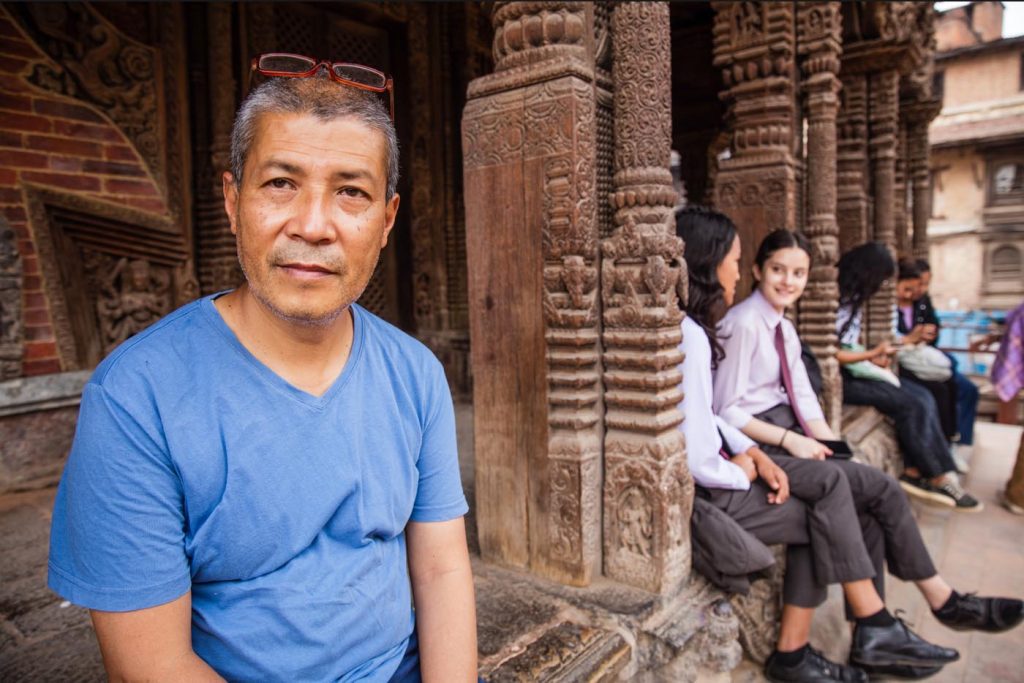
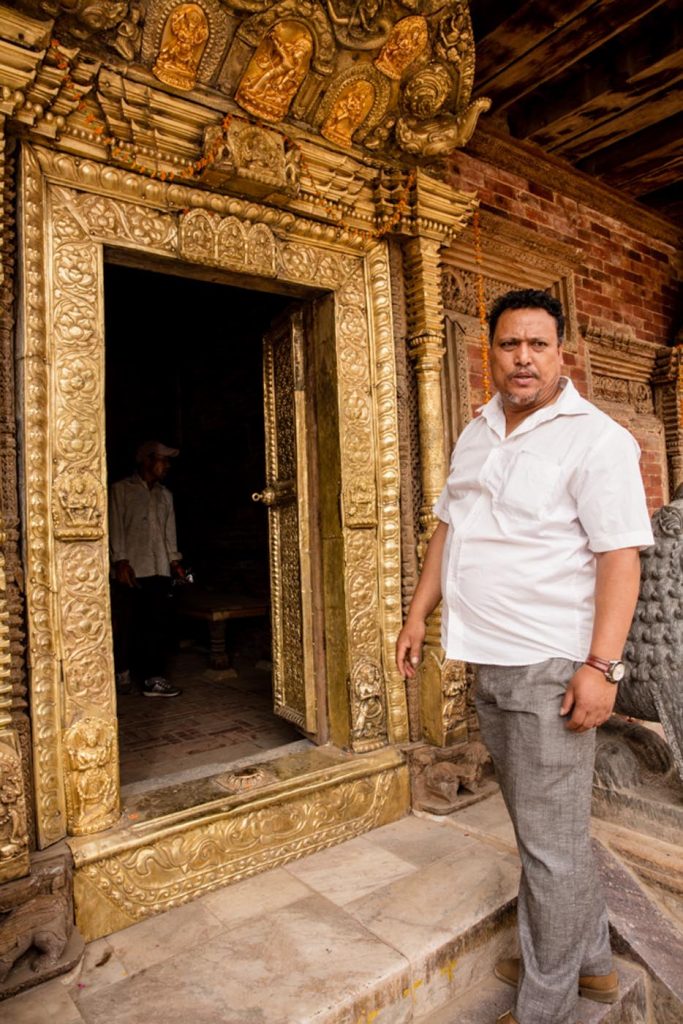
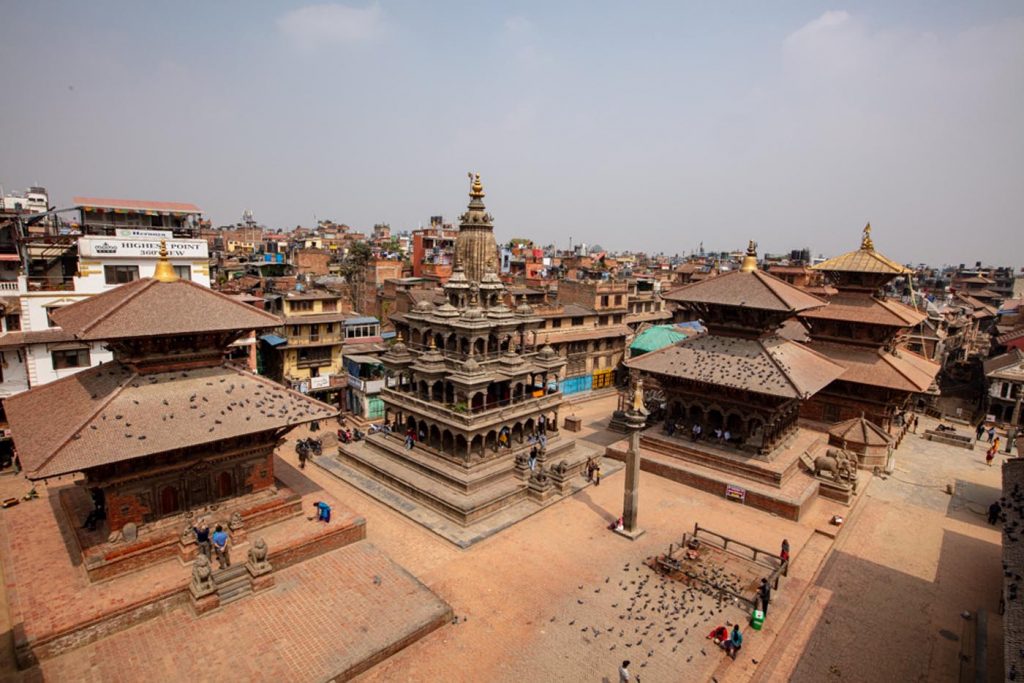
It is only since the earthquake, observing the great monuments of the square reassembled to their original splendor, that I have learned the names and individual identities of each temple. My curiosity about them grows as I watch the pagodas under repair by local builders and craftspeople of rare skill. “You know, there is money for conservation, but if we don’t have artisans, what can we do?” says Ravi. “They are the backbone of conservation. And it is not just the work of individuals, but the work of the team.”
Even now, not all of the temples have been fully restored. With the pandemic, national priorities shifted and building costs rose. Here we describe several completed monuments and their histories, shaped by the gifted artisans who recently restored them.
Char Narayana Mandir
Char Narayana Mandir is the square’s oldest major temple; construction was begun in 1563 to honor Narayan (Lord Vishnu). Built primarily of brick in the pagoda style, it has two tiered roofs supported by carved struts.
In Newar woodcarving, the struts are not merely functional; they are also artistic, protective and divine. Wooden struts of valley temples of this era had up to sixteen carved arms in various positions, their hands often holding objects that made clear the identity of the temple Deity. Twenty struts support Char Narayana’s lower roof; twelve of these depict Vishnu as the cowherding Krishna. Nepal’s kings were believed to be incarnations of Vishnu, so temples were often dedicated to His various forms.
Char Narayana collapsed down to its plinth in the 2015 earthquake. Within a week, its original veneer bricks and carved elements were rescued and stacked neatly around the square. Photo documentation helped in the reuse or repair of five broken struts and other broken parts, so that the temple could be rebuilt almost as it was.
Workers salvaged 162 of these carved wooden arms from the rubble of the Char Narayana and nearby Harishankara temples, but most were too badly damaged. The struts (with identifiable arms reattached) were reinstalled on the temples, and 102 of the unidentifiable arms were displayed in a Patan Museum exhibition showcasing post-earthquake rescue and conservation efforts.
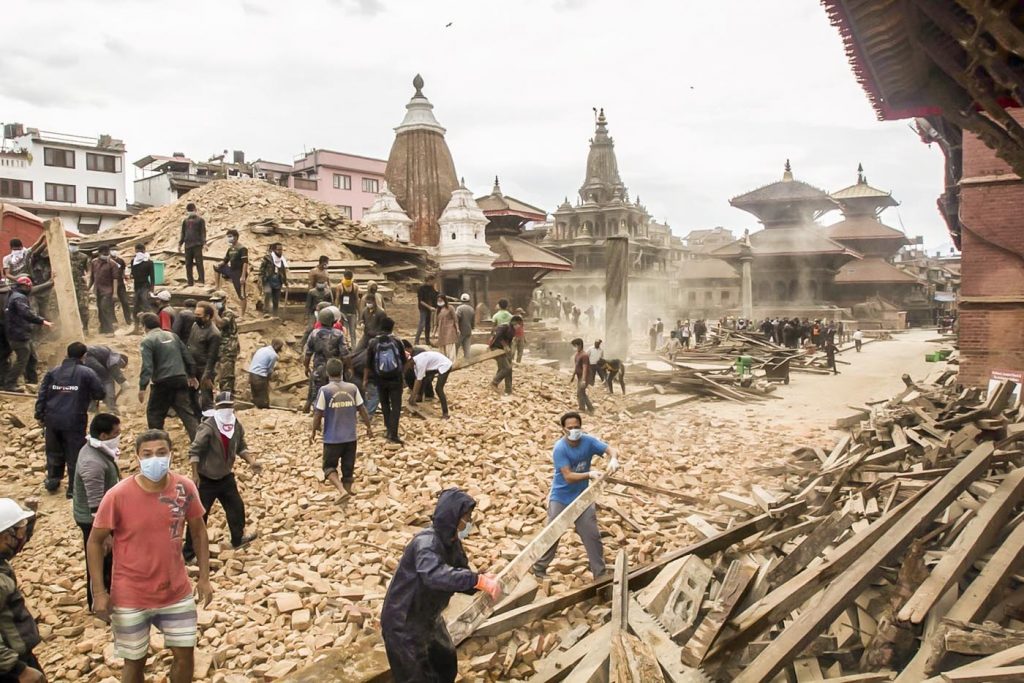
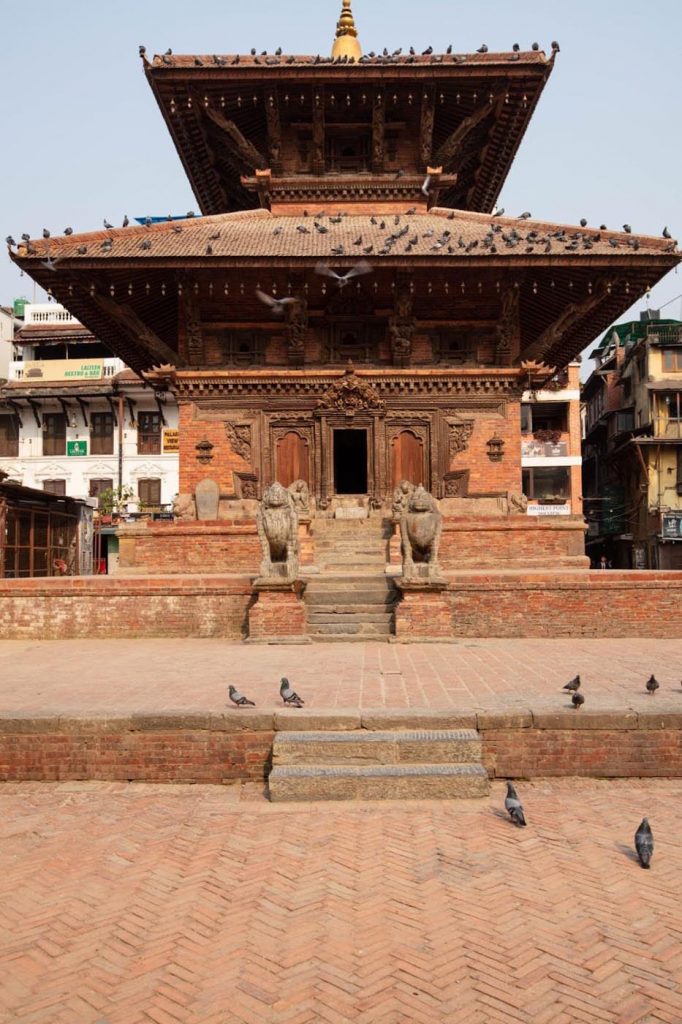

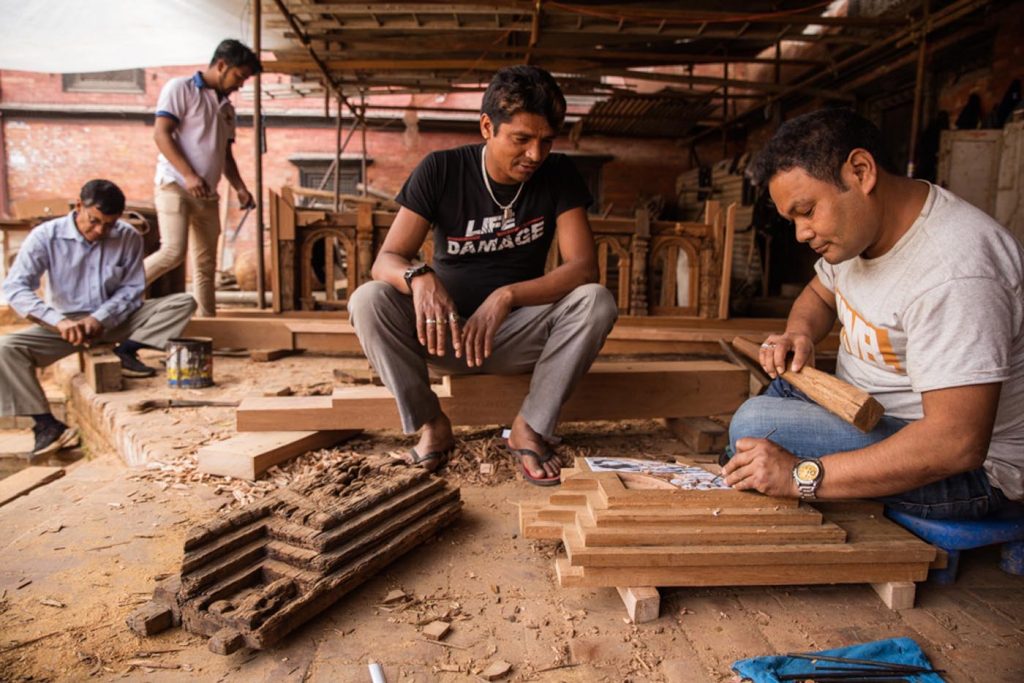
Shiva Chauguthi, Head Carpenter
Shiva Chauguthi learned to make furniture as a boy in Bhaktapur, a city famous for its woodworkers and carvers. Jointing timber correctly, he tells me, is the hardest thing for a carpenter to learn. He describes the challenges of working on the scaffolding erected on temple roofs, overseeing the laborers who had to join huge pieces of timber according to precise measurements. It took months to find proper sizes of timber, with some 11” x 14” pieces a full twelve feet long. “At first I wondered, how can I do this? But now I can show what I’ve accomplished. Two years ago, KVPT appointed me head carpenter!”
Until recent years, wood was abundant in Nepal. It is in this medium that Newar craftsmen have most excelled. The carvings on door and window panels, arched toranas, end beams, columns and capitals all are significant in their iconography and demonstrate the artistic invention of the carver. Wooden temple struts of the Gods not only offer divine protection, but also provide instruction. For instance, below the depictions of Siva or Vishnu on the Harishankara Temple are small scenes showing results of evil deeds, with inscriptions such as, “Who abandons his dharma is stung by hornets.”
Indra Kaji & Indra Prasad Shilpakar, Woodcarvers
Following the tradition of generations of Shilpakars (the Newar caste of woodcarvers), Indra Kaji Shilpakar started sanding wood when he was ten. Guided by his father and uncle, he began carving at age 12, using the tools made traditionally by the Khami (blacksmith caste). “When I saw the damage of the Patan Durbar, I wondered how it would ever be rebuilt,” remembers this renowned master carver. “But I was called immediately to begin work on several temples.”
To begin the reproduction or repair of a strut or door panel, Indra Kaji draws the imagery for his relatives to roughly carve. He is familiar with traditional iconography and often refers to images of Deities drawn by his grandfather. When he has no model to work from, he must reimagine a carving of a God by studying carvings of other Gods: “there are so many questions to solve—how many arms, what the Deity holds,” he explains. Then he or his son Indra Prasad complete the final intricate carving. When it is time to install the finished piece, they know in which direction to install it: for instance, in the local Siva temples Ganesha will always face south.
Indra Prasad has a masters degree in fine arts, specializing in sculpture. He admits, “When we make carvings for private orders, we can earn more income. But the public doesn’t see those pieces. We like restoration work, because it stands out. When people can see our work on the square, we feel pride.”
Yet public work comes with a peril. A strut his father had painstakingly carved for Patan’s Sulima Temple was stolen and never found. “Once the carved work is public, there are so many risks—for instance, kids put their bubble gum in the crevices,” Indra Kaji says woefully.
Their struts, columns and most recently, carved window panels for the square’s Bhai Degah Temple are carefully documented on Indra Prasad’s mobile phone: A torana (an ornamental arched piece above a portal) may take five months to carve, and a single panel flanking a door or window 5 to 6 weeks. “One thing we had not known before the earthquake is how our ancestor carvers saved time, putting the most intricate carving closer to the ground where we can best see it. So, a first-floor temple window may have the carving of a God. The floor above may have a lion, and then above that a bird, and then perhaps only a small motif on the top level.”
Despite their success, they worry their profession may not survive into the next generation. Large pieces of wood are hard to obtain. The even bigger issue is passing on the skills: “We need the government or some organization to create a university to teach our carving arts and give certification,” explains Indra Kaji. Like other Nepalese craftsmen, he wishes the government would provide more support and appreciation for craftspeople and quality restoration. KVPT has tried to fill this gap.
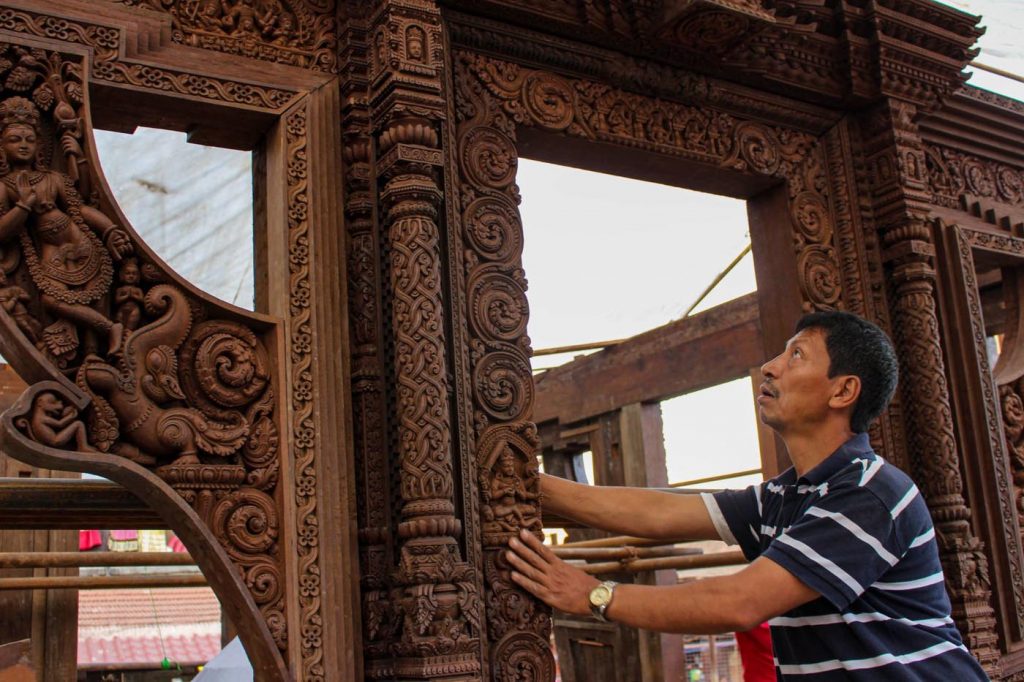
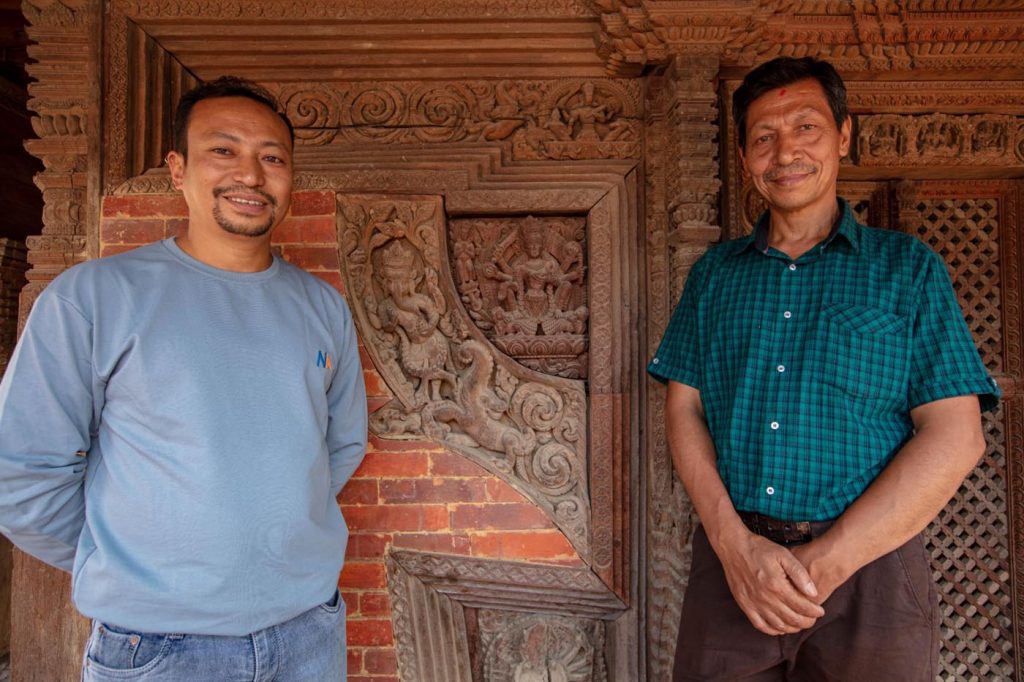

Harishankara Mandir
Though it had survived the earthquakes of 1809, 1833 and 1934, this three-tiered temple built in 1706 collapsed almost completely in 2015. Soon after the earthquake, 2,000 parts were sorted, documented and repaired. By 2017, the entire first level of the temple—including columns, capitals and beams—had been “test-assembled” in KVPT’s workshop. It was then disassembled and reassembled on the empty plinth. By 2018 the second-level timber elements were installed, and by 2019 the third level was completed. Roofs were covered utilizing 16 truckloads of yellow mud topped by jhingati (overlapping clay tiles). Finally, metalsmiths Babu Ratna and Binod repaired and re-gilded the roof pinnacle.
The reconstruction, spanning four years and requiring several thousand man-days, succeeded in reusing 90% of recovered historical materials while improving seismic strength at the same time. Only when restoration was completed could the Deity, Harishankara, inhabit the temple again. Harishankara is the eight-armed manifestation of Vishnu (Hari) and Siva (Shankara).
During the earthquake, the Harishankara murti had broken diagonally at the waist. A unique collaboration between local engineers and craftsmen with students and professors from the University of Applied Arts, Vienna, helped to repair the almost five-foot-tall sculpture so that Harishankara could be returned to the temple sanctum.
Rohit recalls working out the challenge of its repair: “You cannot plan the reassembly on paper—you have to hold the sculpture and find the thickest parts where it would be safe to insert steel dowels.” But even after reassembly, the statue could not be worshiped; tradition does not allow the worshiping of a broken statue. So master stone carver Amar Shakya put a photo of the original on a smaller stone and made a smaller replica, less than one foot tall. The temple priest gave the new statue life during a fire puja (homa), a ritual of regeneration. Now, both the original and the new God reside together to receive worshipers in the temple’s sanctum.
Amar Shakya, Stone Sculptor
Amar says it has become harder and harder to find good stone, and he often needs to move his workshop when neighbors complain about the noise of chiseling and hammering. His children work on computers and not with the hammer and chisels of many types that he learned to use from his father. Yet he has found satisfaction working in this project: “Before I was hired to work on the square, I did not take so much notice of it. But now I’ve looked hard at everything and it has inspired me in my profession.”
Amar shows us places in the square where KVPT has not just restored or replaced earthquake-damaged pieces, but also added stone images that had been stolen or had never existed. He is particularly proud of an image of Mahalakshmi, eternal companion of Lord Vishnu, representing prosperity and abundance, which he carved to replace a stolen image in the Vishveshwara Temple.
Krishna Mandir
Krishna Mandir, a three-story square stone shikara-style temple, is the most important temple for Vaishnavite Hindu pilgrims from all over Nepal and India, who visit especially for the celebration of Krishna’s birth (Krishna Janmashtami). The term shikara refers to mountain peaks, which are suggested by the temple’s 16 open-air pavilions peaked with 21 gilded pinnacles. Its style, unique to Nepal, was compared to Mount Meru. Surrounding the ground floor are narrative friezes carved with 55 scenes from the Ramayana; on the floor above are 36 scenes from the Mahabharata. Legend has it King Siddhinarasimha Malla in a dream saw Radha and Krishna in front of the palace, and so he built a temple on that spot.
The temple miraculously withstood the 2015 earthquake, but base and corner stones and other elements had long been dangerously disintegrating due to insufficient repairs after prior quakes, and stone columns were out of plumb. Designing a way to shore up the building and replace four bearing corner stones on the second level, which houses a Sivalinga, required a steep learning curve for KVPT’s small team of Nepalese architects, engineers and stonemasons. Stones weighing up to 1,540 pounds had to be lifted to a level almost 16.5 feet above the square. Then the damaged corner stones had to be removed and replaced, a dangerous procedure that could have jeopardized the stability of the building. The repairs, which took nearly three years, were finished just in time to celebrate Lord Krishna’s birthday in 2018. Surya Bahadur Ranjitkar and his father, Asha Bahadur Ranjitkar, were an integral part of the repair team.


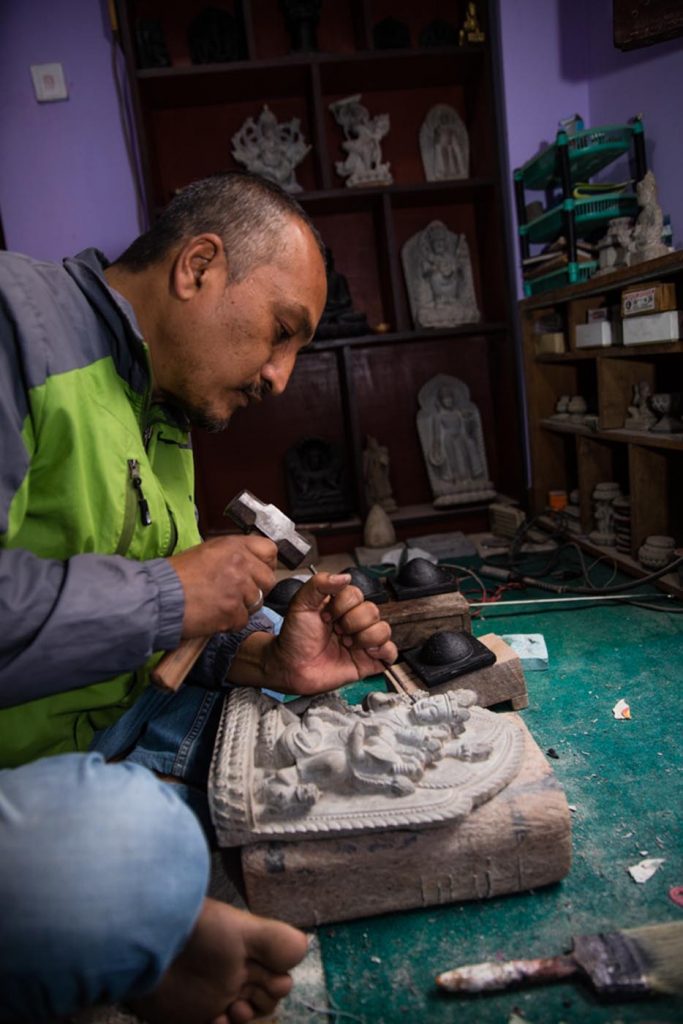
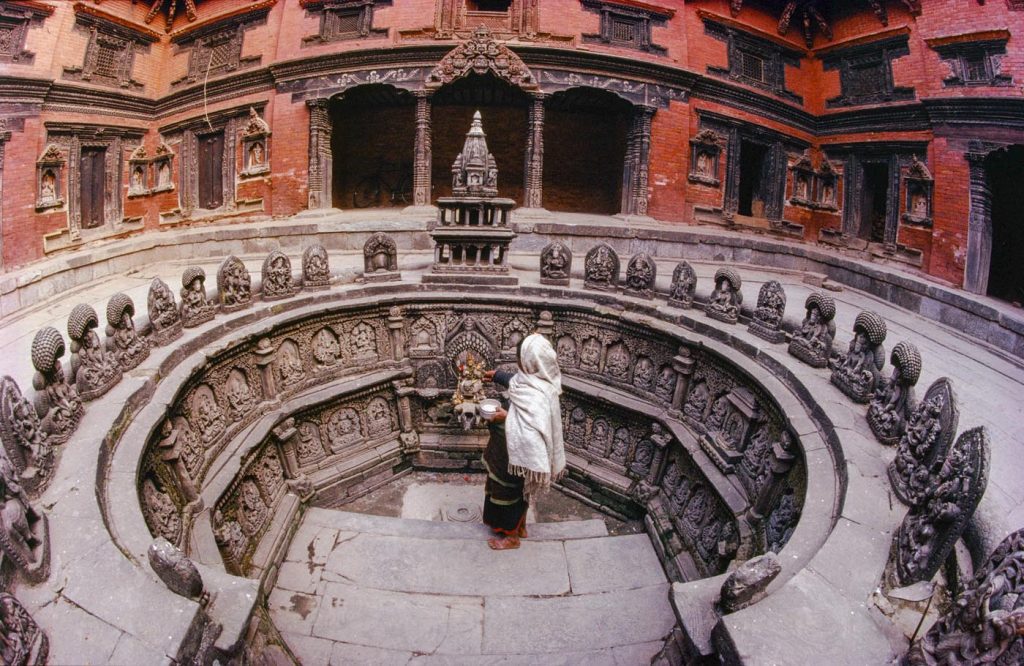

Continuing the Lineage
Surya Bahadur Ranjitkar is descended from a line of stone carvers. After 13 years working with KVPT, his expertise is vast. Few buildings in Nepal are made of stone, so knowledge of their repair is limited. Surya Bahadur took part in a training program provided by Professor Ramesh Bhole and Dr. Neeta Das from India, where he learned a system of numbering stones so they could be reused or repaired. Then he set about repairing or carving new stones, and reinserting them using lime surkhi (brick dust) mortar.
On the second story of the Krishna Mandir, he shows me the heavy 14” x 14” base stones he had carved and then replaced, climbing up and down a heavy scaffold for days. “I was scared because the stones were so large and heavy, but I wore a helmet and used a chain pulley. ‘I can do it myself, and it won’t be hard,’ I kept affirming. ‘Just work slowly.’”
A KVPT publication documented the precarious work with photos and captions: Surya Bahadur checking straps as the corner stone is removed; with the temporary steel post; preparing to fill joints with mortar after installing the new corner stone….
Slight and nimble, he leads us through the square to see all the carved stone gateways, stone lions, base stones and temple pillars he has worked on over the years. “In the history of the Patan Square, I know my name is here.”
Tirtha Maya Tamang, Cleaner and Laborer
On restoration sites, women are cleaners and carriers of bricks and debris. Before the grand opening of the Bhimsen Mandir, I meet Tirtha Maya Tamang, 35, cleaning the gilded doorway with its new repoussage (hammered metal relief) Deities placed in the torana above and along the sides. Tirtha Maya used to sell jewelry on the square to tourists. She points to her husband, Rakesh Shrestha, who is operating a pulley to raise bricks to a scaffold nearby. “He used to drive a taxi, but since the pandemic we work here together, and we like it,” she says.
Vishveshwara Mandir
Both roofs of Vishveshwara (Lord Siva, Lord of the Universe) Temple, consecrated in 1627, collapsed in the rains of 1989. The damaged stone elephants were at the time poorly patched with cement and stand at the front of the temple, serving as a reminder of this event. As Rohit reminds me, repair and restoration are ongoing processes.
The carved wood columns on the temple’s first level form what scholar Niels Gutschow calls a “virtual forest of sturdy pillars.” In 2015, this timber structure saved the temple when its brick walls collapsed. Now the brick masonry has been rebuilt, and the precious columns have a steel skeleton to take the load.
“Conserving doesn’t mean you have to build from scratch,” says Rohit, who is critical of quick rebuilding efforts that take place without research and investigation. Though some of the temple’s stone bases were broken, “We salvaged the stone pieces and rejoined them. Most people don’t think about the importance of saving materials, the importance of things that are old.”
Bishwo Ram Suwal, Brick and Stone
Buildings of the Newar towns and cities were traditionally constructed of timber and brick, and narrow alleys and squares were predominantly paved with brick. Unique to Newar brick construction is the use of daci apa brick, a type of exterior veneer brick that tapers towards the back, with the front face showing almost no mortar. This high-fired deep red brick makes a beautiful smooth wall surface. Behind it is an interior layer of low-fired brick called ma apa. A core of rubble brick fills the space between these outer and inner layers.
Few people today retain the ancient skill of bricklaying. Bishwo Ram Suwal, 53, is a master mason who has worked for fourteen years with KVPT, laying brick and paving stones and installing the heavy base stones of the Durbar’s temples. After the earthquake, seeing the salvaged bricks carefully stacked in piles around the collapsed temples, he knew that the rebuilding could be done. Where temples had collapsed completely, the task was relatively straightforward: he simply started with the foundation and built upwards. Much harder, he says, was repairing walls that still stood but were fragile—since the whole temple might suddenly collapse. While repairing walls, he came up with new ideas, such as a system of interlocking outer and inner bricks to make the walls more resilient long term.
Bishwo Ram says humbly, “We are lucky to have the chance to work on these monuments, as they are the gift from our ancestors. In working on them we see their skill.”
The Pillar of Yoganarendra Malla
King Yoganarendra Malla erected a 26-foot stone pillar in 1693. A metal sculpture on top depicts an elegant king sitting in a large lotus with his hands in Anjali mudra (prayer position). The king is flanked by two diminutive wives, who also hold their palms together. He is symbolically protected by a large naga (serpent Deity) and is armed with two swords and a shield. Yet the king’s statue was not protected from the earthquake. Rohit explains, “The statue was smashed beneath the fallen pedestal, bending the king at the neck and waist but fortunately not damaging his head. Everyone wanted to make a new one, but the old is valuable—it has history. We are not here to create Disneyland. We put a steel skeleton inside the statue to strengthen it, and we put steel in the pedestal to bear the weight of the statue. With help from the Viennese conservators, we gilded the areas that had been damaged by hammering the king’s body back into shape.” The reinforced pillar was erected in 2016, using a crane. In 2017 the king and his wives once again perched high above the square.
Babu Ratna Maharjan and Binod Maharjan, Metal Craftsmen
“I grew up playing amidst the temples on the Patan Square and had a creative mind,” relates Babu Ratna. Rather than follow his caste’s farming tradition, he began to draw and make his own tools and teach himself the skills held by the tamrakar (metalworker) craftsmen in his neighborhood. For 20 years he has worked for KVPT, making repoussage and developing new technology for installing stone pillars and blocks. He often works with his friend Binod.
When the Yoganarendra statue fell, the stone pillar did not break, but the gilded copper lotus holding the king’s statue was detached. “When I work on something old, I learn how it was assembled and find a way to improve it,” he says. He modified the iron structure within the metal lotus so it would hold more securely to the pillar.
He hammered out each part of the lotus, and used a jack to straighten the iron rod within the snake. He disassembled and repaired each part of the king and his queens. “Making something new is easier than repairing the old. From KVPT I learned how to conserve with quality, take time, and not to compromise.” I ask about the most challenging aspect of his work after the earthquake. “It is not difficult, but it takes time. If you apply too much heat while welding one place, it can crack someplace else.” Repairing the king’s lips and the folds of his clothing required the most careful touch, he explains.
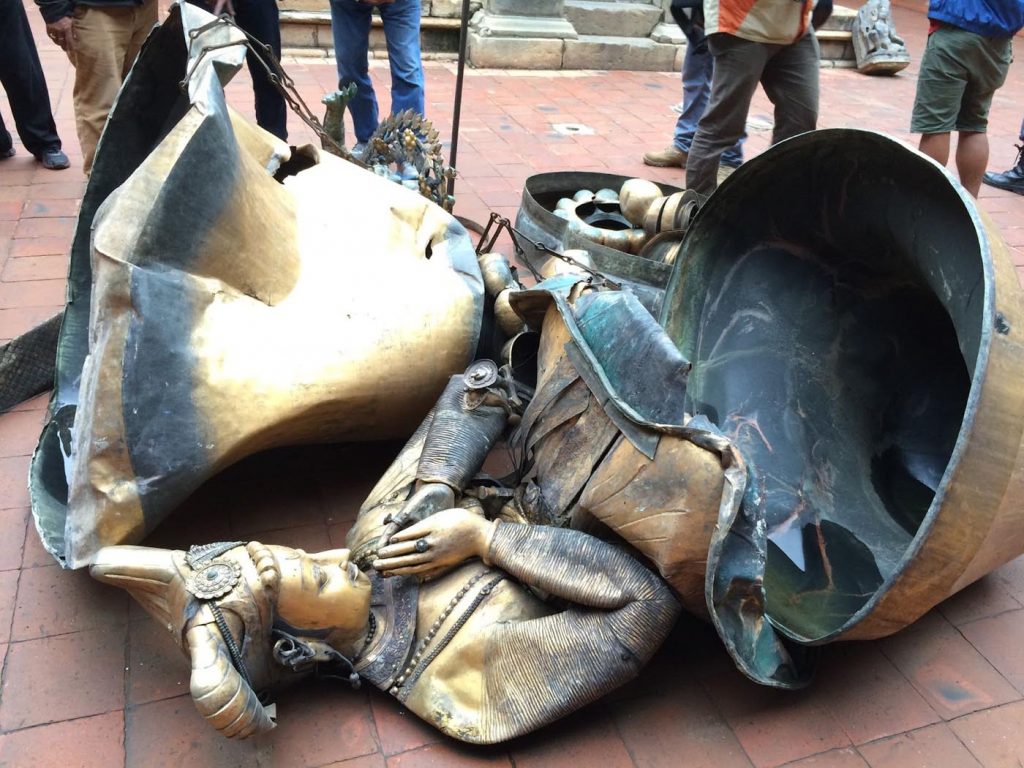
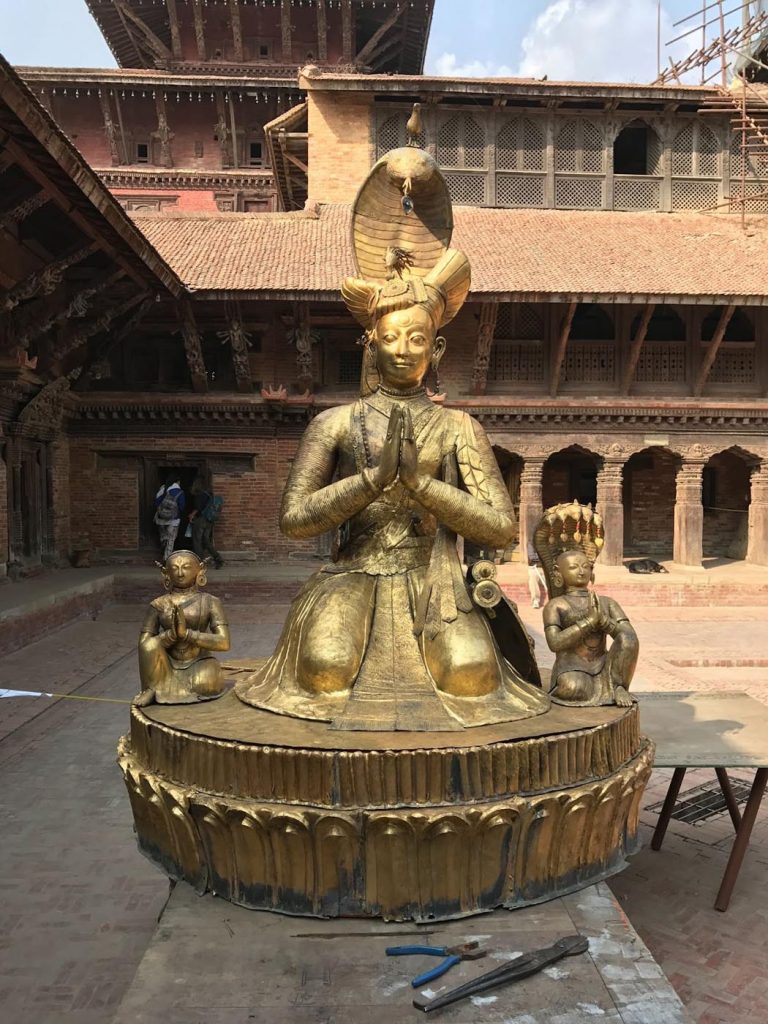

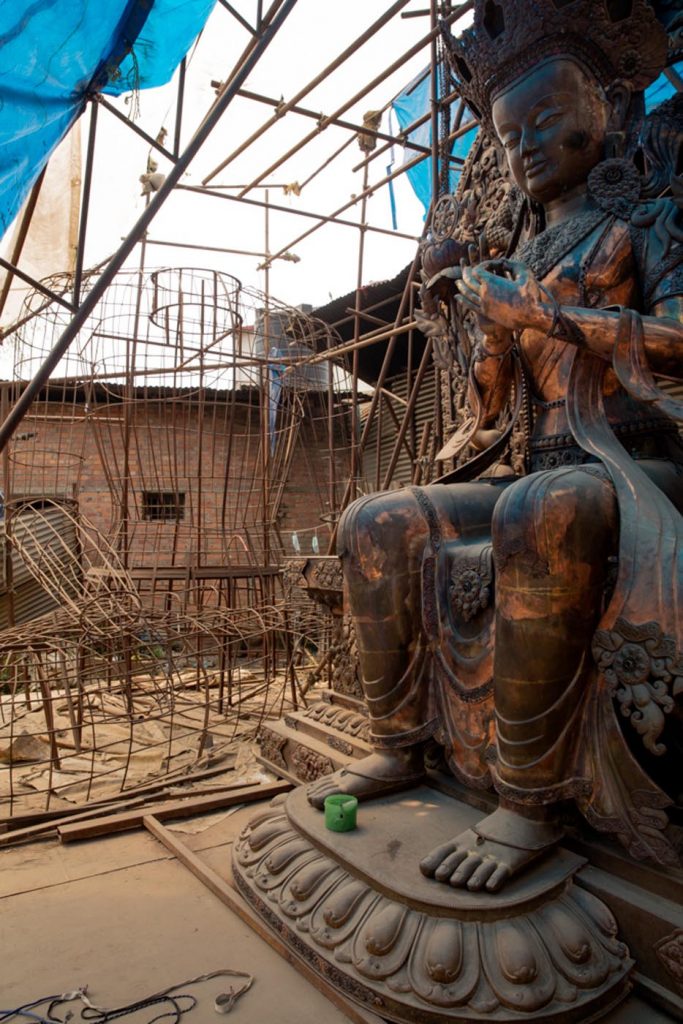
After Babu Ratna had reassembled the Yoganarendra statue, the Viennese conservation experts introduced a new way to gild using glue and gold leaf. The traditional way used by most artisans is to mix gold with mercury, which is extremely poisonous. The gilder puts a piece of raw meat in his mouth and then rinses with alcohol, believing this will prevent toxicity. Artisans prefer this method, Binod explains, because even though it is dangerous, it lasts longer, whereas new methods require replacement in fifty years.
Babu Ratna and Binod lead us around the square to show us their repairs. They point to the gilded copper pinnacles on the Krishna mandir that they reattached with methods to block water damage, and new metal supports they created for many of the mandirs’ wooden pillars. They used their skills and ingenuity to invent practical conservation solutions. Babu Ratna emphasizes again and again how conservation needs creative minds. Binod adds, “I never thought the square would be rebuilt in my lifetime. Now I come here with my child and am so proud—rebuilding is part of our story.”
Bhimsen Mandir
One of the five Pandava heroes from the Mahabharata, Bhimsen is worshiped by Newars as the protector of trade and commerce. Bhimsen Mandir, a favorite of local people, is duly resplendent with a top roof clad in gilded copper, gilded copper roof finials on each of the three roofs, a projecting bay window clad in gilded copper, bronze bells along the roof eaves, elaborate struts depicting Bhairav, Ganesh and Siva, and a long metal banner that hangs from a middle finial on the third roof. After the earthquake, the temple required bracing on all four sides. KVPT’s artisans not only strengthened the building, but replaced stolen images around the gilded copper repoussage door frame. With the temple’s splendid metal decorations gleaming, the Prime Minister of Nepal recently consecrated its reopening.
Rajindra and Rabindra Shakya, Metal Carving and Repoussage
Brothers Rajindra and Rabindra Shakya were contacted by KVPT to make the new repoussage images of Gods that had been stolen from the Bhimsen Mandir. They had learned their skills as children from a family member, and Rabindra continued his training in an arts university. Their workshop maintains the high level of quality that Newars have attained in metal working. Here giant Gods and Buddhas are created for monasteries all around the world. The work involves drawing a design to a sheet of metal, setting it in pitch and hammering from the backside and then setting it in pitch again and carving details with hundreds of chisels.
They do not know whether the next generation of their family will continue their metalwork tradition, but for four years the brothers have provided training to three boys of the Tamang ethnicity, all in their early twenties. I ask Sushan Tamang what has been the hardest thing to learn, and he explains how difficult it is to hold the chisel steady due to the vibration from the hammer. “That these boys are interested to learn is so important for the future,” comments Rajindra, “or else our profession will not continue.”
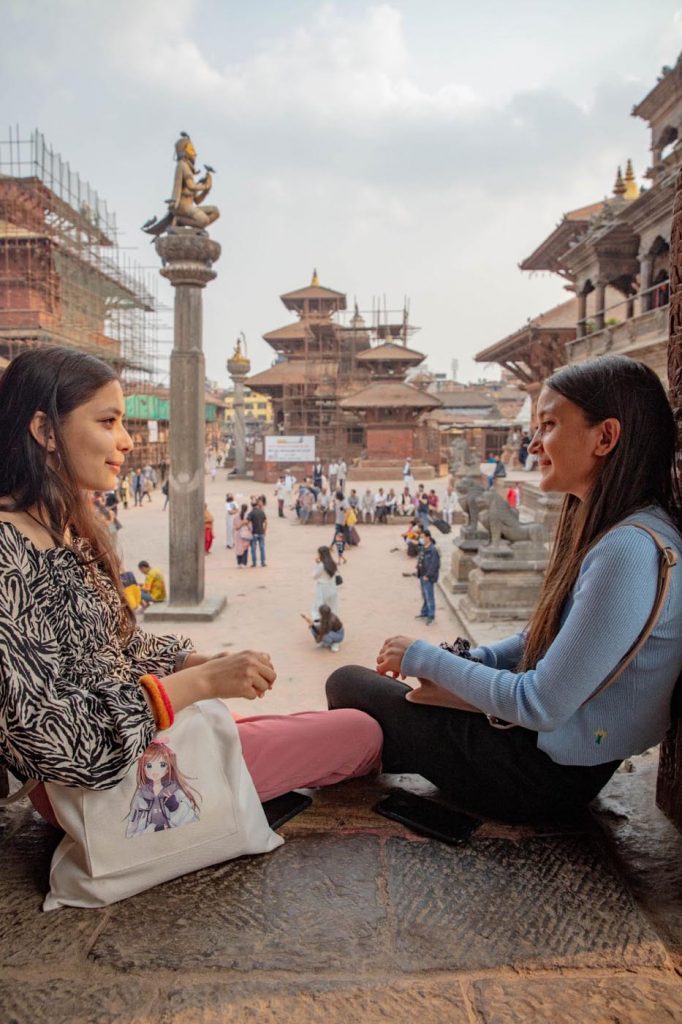

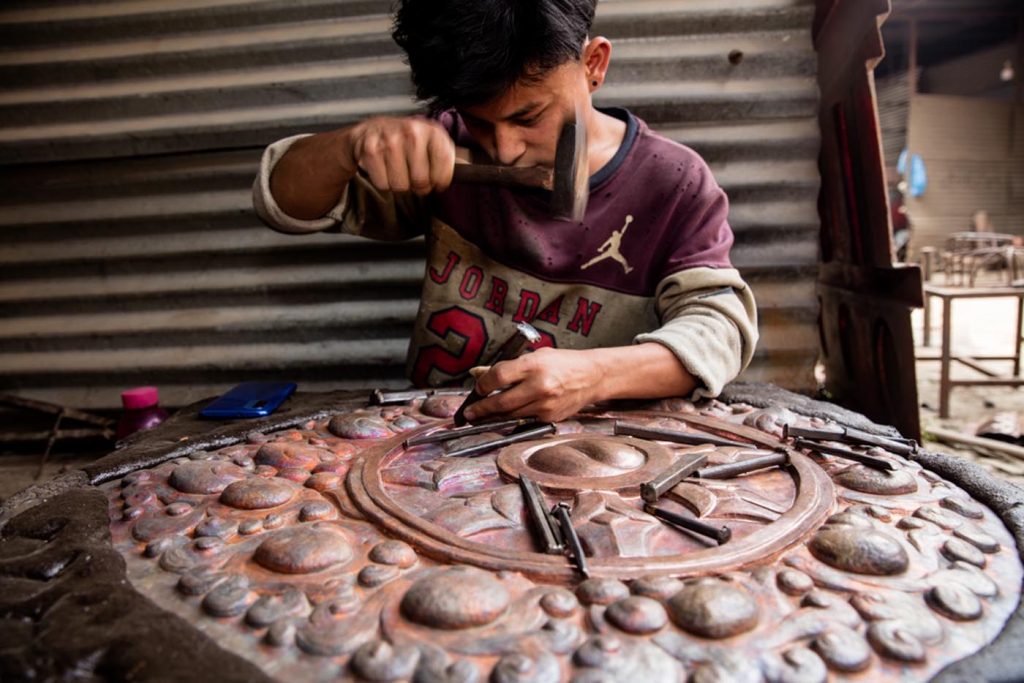
The Future of Patan Durbar Square
Patan Durbar Square is a model conservation effort, led by the Kathmandu Valley Preservation Trust in cooperation with the Department of Archeology, Government of Nepal. The square is included in the UNESCO World Heritage List. But everything depends on the living masters of the necessary crafts.
Rohit points out that preserving the square is not only about conserving buildings, but preserving the ongoing specific worship, rituals and festivals associated with each edifice. The temples are where Gods and people meet.
Daily, in the bays between carved columns, young couples watch TikTok on their mobile phones, old men shoot the breeze and schoolgirls sip cups of bubble tea. Young children play on stone lions, and students in school uniforms pose on temple steps for class photos. The square is alive and has never been more visited and appreciated.
Before their morning class, three IT students, Prashant, Shishir and Benuka gather on the plinth of the Harishankara Mandir. “We do our puja at Krishna Mandir,” Prashant says, “and we like to be near our old culture.”
After their classes in business administration, Puja and her friend Aakriti sit in front of the Patan Museum enjoying ice cream and watching the activity. A bride and groom in elaborate wedding clothes pose for photos with temple backgrounds. There are children with balloons, the ever-present dogs, more students with ice cream. Puja reflects that youth have a responsibility for the cleanliness of the square: “It’s youth who understand most about pollution and the environment, but we are also more into ice cream. We cannot carelessly discard our ice cream wrappers and other trash or spit gum without thinking.”
In a secluded bay of the Vishveshwara Temple, 16-year-old Prasant is drawing the face of his friend Rijisha. “I used to play here as a child,” he says. After the earthquake, when he was but nine, he asked his parents to donate money for rebuilding the square. From his sketchpad he shows me a detailed pencil drawing of the temple. “Slowly, I will draw them all.”
“I’m just chilling,” says Sanjog Rai, a business student. “With all the temples, it’s a nice place to hang out with my friends. People feel happy here—it has a good vibe. I’m glad the square is well taken care of.”
With the care of KVPT, the artisans and the local people, the square is in good hands. But as Rohit reminds me, “Conservation is an ongoing effort. There is much more to be done if we want to keep these buildings for the future.” For more information on KVPT, and if you wish to donate, please visit:
kvptnepal.org
Re-creating what once was has its challenges. Missing sculptures must be remade by the most skilled of artisans

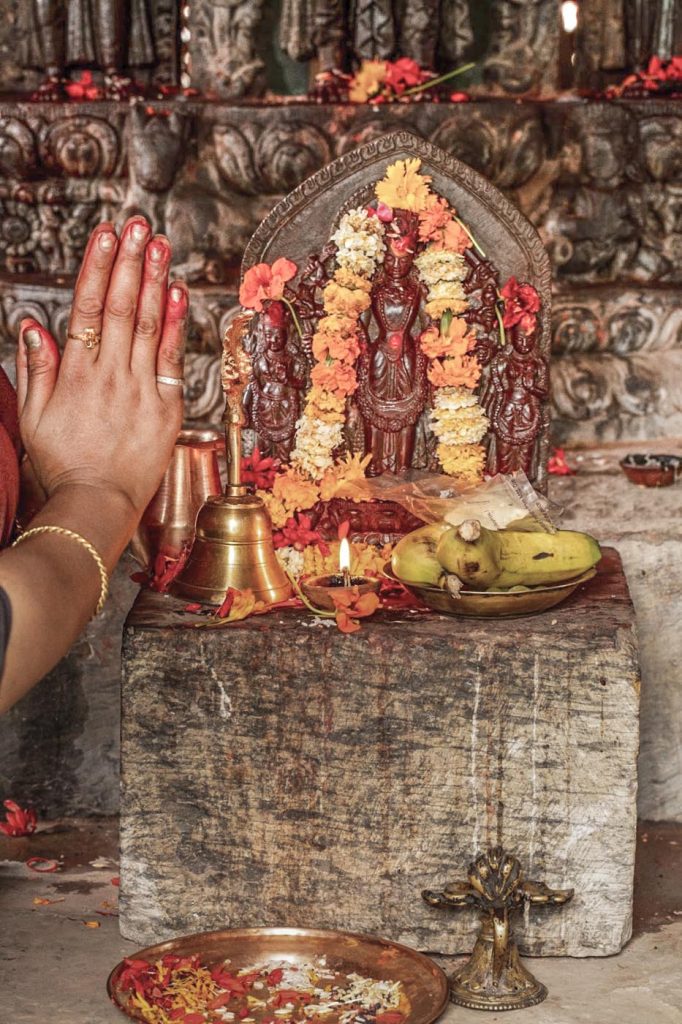
Bandana Jha, priestess
For hundreds of years, the relatives of Bandana Jha, 35, have performed rituals and daily puja for the square’s temples. When a priest who had performed puja for the Harishankara Temple for nearly half a century could not carry on, she and her mother-in-law, Manimaiya Jha, took over. “Men will continue to carry out rituals such as homa, the fire ritual bringing renewal,” she says, “but in the future maybe only women will perform daily puja. The younger generation of gents are too busy.”
Bandana rises at 4:00am to bathe, then performs her house puja. Next she goes to various temples in her neighborhood, worshiping Ganesh, Uma Maheshwar and Harishankar. Arriving at the southern end of the Patan Square, she performs puja in a Krishna temple before arriving at the Harishankara Mandir at 8:30am. “I don’t feel hungry,” she says. “God gives me energy.” Widowed in her teens, she lives with her mother-in-law and son. “God is my family.”
The doorways to the temple’s inner sanctum are flanked by carvings of the Eight Mother Goddesses, powerful protectors of the city and of individuals. Four, lost in the 1970s, were replicated during the temple’s reconstruction by Indra Kaji Shilpakar. Taking off her sandals, Bandana unlocks the door to the sanctum, enters and sweeps the floor of dust and debris. In the center of the sanctum stands the impressive statue of Harishankara. The right half of the image, Siva, is flanked by a smaller Uma Parvati, while the left half, Vishnu, is accompanied by Laxmi. The murti has been so well repaired one can scarcely see the damage, but a replica image carved by Amar Shakya rests on a stone block below it. “God is in both,” she tells us, “But the old one is imperfect for worship. With only the old one, our puja is not valid—it is incomplete.”
She washes the great old statue and then the small one with water and lights an oil lamp. On a copper plate she has assembled rice, black sesame, unhusked grains of barley, red and yellow powder, and orange and red petals. She scatters petals and grains on the feet and then the heads of each murti, and then marks with red powder the feet, navel, arms and head. More flowers and grains are given to the Deities, with grains offered to their mouths to feed them. She rings the bell, calling the Gods and chanting, “Harishankar Narayan, Om Namo Bhagwati Basu Devaya Harishankar Mahadev, Om Namo Shivai.”
Bandana offers bananas and sweets to the Gods, then lights and offers incense. She ritually washes her face with the smoke, a blessing from the Gods, then touches her head to the feet of each.
The Gods have accepted her prayers. She returns home to make tea and have a meal with her mother-in-law, satisfied that the Gods are fed and cared for till the next day.
Author & Photographer

Author Claire Burkert is an American based in Kathmandu. For over 30 years she has worked with artists in Nepal and other countries, with a focus on promoting indigenous traditions of architecture, craft and design.
Thomas Kelly is a renowned photographer who has provided photographs to Hinduism Today for many years. He is also based in Kathmandu, Nepal. See: thomaslkellyphotos.com wild-earth-journeys.com
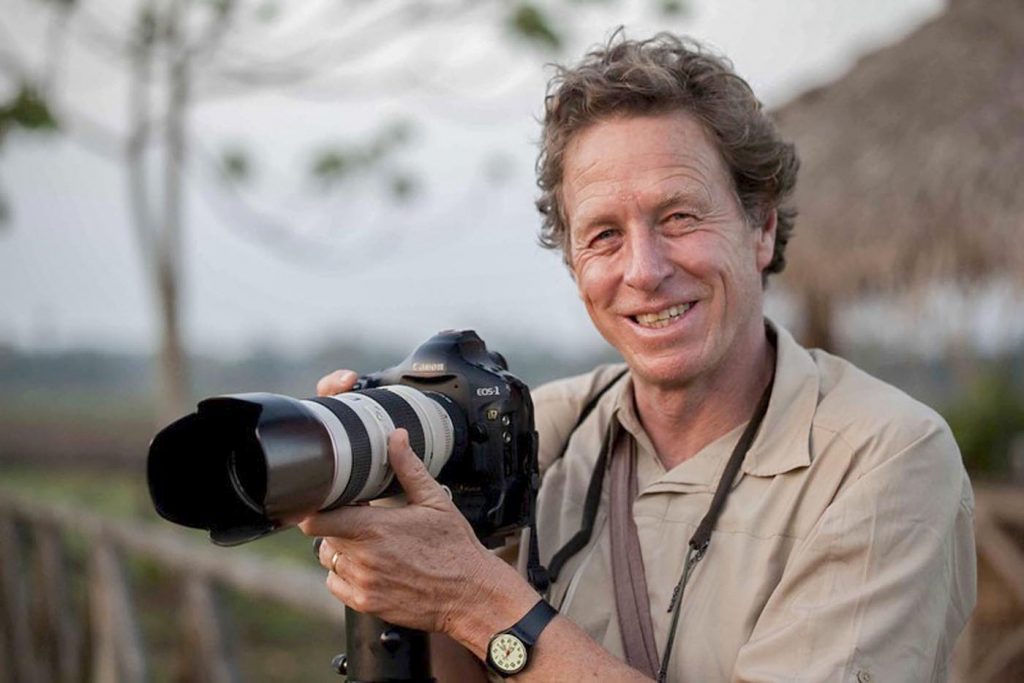

Very good read !